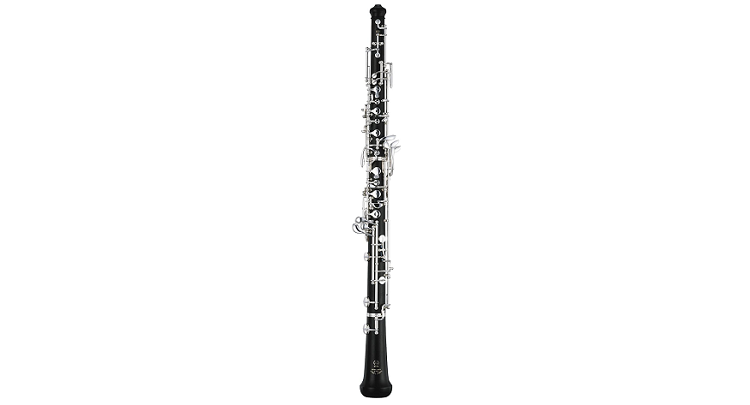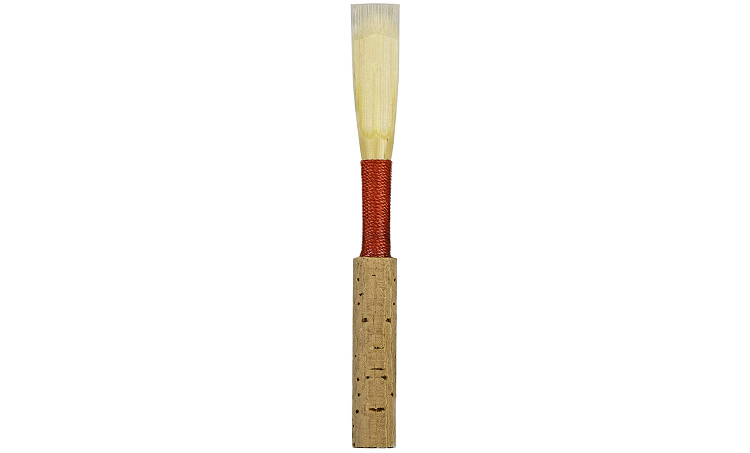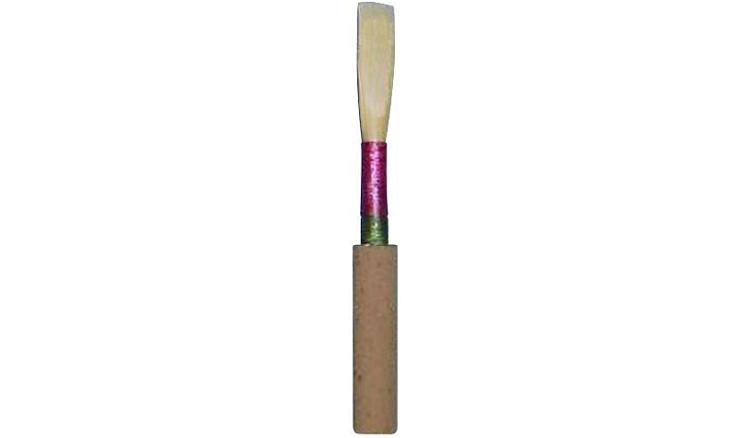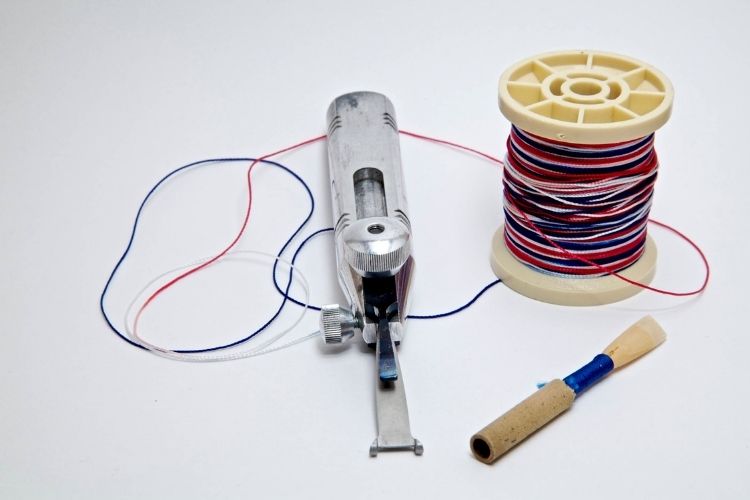- Top Trumpet Embouchure Techniques: Options for Beginners Through Professionals - October 12, 2022
- Is the Trumpet Hard to Learn? - September 30, 2022
- Best Leblanc Clarinet Models Guide: From Soprano to Contrabass - September 5, 2022
Are you tired of competing with a dozen flutists or clarinetists but still want to play music? Consider learning how to play the oboe. It’s not nearly as common or competitive, so you may get more performance opportunities. But the instrument takes a lot of skill to play, and you need to know how to learn it the right way.
What Is the Oboe?
The oboe is a member of the double reed section of the woodwind family. Like the bassoon, the oboe uses two reeds bound together by string to make a sound. You put the reed into the top of the oboe body, and then you form your lips around the reed and blow to play. Like other woodwinds, it has multiple keys on the body that you open and close to change notes.
Its mechanism takes inspiration from the Boehm system used on flutes, clarinets, and saxophones. However, there are some differences that can either help or hinder players from switching to the oboe from those instruments.
Oboe Specs
A basic student oboe has keys that allow it to play down to the B just below middle C. However, more advanced models may have a low Bb key, so you can play a note lower than a student model.
Intermediate models also tend to have a left-hand F key that allows you to play the note F natural more easily. This comes in handy when moving between F and D because the standard F fingering uses a key that makes that switch awkward.
You can also get multiple trill keys to help facilitate fast switches between multiple notes. As far as materials go, student models tend to use a plastic resin, while intermediate and professional oboes use wood.
Best Beginner And Intermediate Oboes
As you learn how to play the oboe, you need a good quality instrument. You can find tons of cheap oboes online, but you’ll get what you pay for when buying your first oboe model.
Investing a bit more can help you get a beginner instrument or even an intermediate one. Then, you don’t have to worry about upgrading your oboe as quickly.
Here are a few beginner and intermediate models to consider when starting the oboe.
Giardinelli GOB-300

The Giardinelli GOB-300 is an excellent student model oboe. It uses plastic resin, so you don’t have to worry about the risks of playing a wood instrument, like cracking. There are silver-plated keys, which are also durable, and this instrument can last a long time. You even get a low Bb, which isn’t that common on student-level oboes.
Undercut toneholes help keep the oboe in tune, which is crucial in an ensemble setting. Orchestras and bands use the oboe to set the pitch, so your instrument needs to have fantastic intonation.
Pros
- Low Bb
- Good design
- Suitable for beginners and intermediate players
Cons
- Not for advanced players
Tiery J10

Another great oboe for beginners and advancing students is the Tiery J10. This model features an ABS plastic upper joint, while the lower joint and bell are grenadilla wood.
That combination offers a nice, warm sound, but it’s not as expensive as some instruments. The silver-plated keys and posts make it easy for you to switch between notes. It has a low Bb, a left-hand F key, and other features that can take you far into your oboe studies. The cork and leather pads can seal well, so you’ll get a good sound.
Pros
- Excellent features
- Grenadilla bottom joint and bell
- Sounds fantastic
Cons
- Pretty expensive
Jupiter Oboe 355

Jupiter is a great musical instrument brand, and the Oboe 355 is excellent for new players. The oboe has a resin body, so you don’t have to worry about caring for wood. You’ll get a low Bb, so you can play the full range that composers use for oboe music. It also comes with silver-plated keys and multiple trill keys to help you play fast passages.
While it’s not wood, the resin lets you get a wood-like sound. Everything comes in a lightweight case, so you can protect your instrument when you aren’t playing.
Pros
- Full oboe range
- Easy to play
- Sounds great
Cons
- Expensive for what you get
Bulgheroni Student Oboe

The Bulgheroni Student Oboe comes from a small workshop on the border of Italy and Switzerland. Despite being a student model, it uses grenadilla wood, and it has a modified Conservatory key system. Its tone and response are both fantastic, so beginners can get a good sound from the start. You can use it as you advance, so you don’t need to spend another few thousand dollars on an upgrade.
This model comes with a case and care products to keep your oboe in excellent shape. That way, you’ll be able to play for a long time.
Pros
- Full wood model
- Excellent sound
- Versatile
Cons
- Expensive
Yamaha YOB-441

An intermediate oboe to consider is the Yamaha YOB-441, and it uses aged grenadilla wood. The instrument uses a modified Conservatory system, which is standard for many oboes. This model has a left-hand F key, making more passages easier to play. It has silver-plated keys that are durable, and the instrument also offers semi-automatic octave keys to help you play higher notes.
Unfortunately, this model’s specs don’t specifically mention a low Bb. However, it probably has that key because it’s an intermediate instrument.
Pros
- Grenadilla wood
- Great features
- Easy to play
Cons
- Not for absolute beginners
Fox Renard Model 330

If there’s one brand you should know as a double reed player, it’s Fox. The Fox Renard Model 330 oboe is a fantastic intermediate option for current players and serious students. This model has a full conservatory key system, including a split ring Eb to E trill. The silver-plated posts and bands add a bit of warmth to the sound, but the body is plastic resin.
With a pitch of A=440, you can play this model in a variety of ensembles. While it’s expensive for a plastic oboe, Fox uses high-quality production methods, so it can be a good option if you don’t want to deal with wood.
Pros
- Good design
- Fantastic specs
- Suitable for all levels of players
Cons
- Very expensive
Best Beginner Oboe Reeds
Having the best instrument is one part of the puzzle when learning how to play the oboe. You can’t play the oboe without at least one or two good oboe reeds. While many professional and serious amateur oboists make their own reeds, beginners can buy reeds. That way, you can start learning the basics of the instrument before you worry about reed making.
Here are some reeds to consider to get you started.
Jones JR101MS

The Jones JR101MS reed is a medium-soft reed, which is great for a lot of players. Professional reed makers created the reed using advanced methods and machines. Oboe players have also tested each of the reeds to make sure they’re playable. That way, you don’t have to worry about buying a reed that won’t work.
These reeds work well in the low and high ranges, so you can play them as you advance. And each individual reed has a long lifespan, so you don’t have to replace it every week.
Pros
- Good strength
- Easy to play
- Versatile
Cons
- Quality control issues
Emerald 601MS

Another reed to try is the Emerald 601MS, which is the reed I used when I learned how to play the oboe. While it’s been a while since I used the reed, I remember it being pretty easy to play. The reed offers a nice sound for beginners, and it’s not too hard or soft. Its strength can be good for playing a lot of different types of music.
You can play this reed as a beginner and as you advance. Unfortunately, the reed can crack, rendering it unplayable despite the overall quality.
Pros
- Easy to play
- Good for beginners and intermediate students
- Versatile
Cons
- It may crack
Singin’ Dog Oboe Reed

The Singin’ Dog Oboe Reed is another option to try, and you can get one from this brand and the other brands. This reed is medium-soft, which makes it suitable for playing various styles.
Singin’ Dog makes reeds by hand, so you can expect better quality than machine-made reeds. The reed is perfect for anyone who is just starting to learn how to play the oboe, either as their first instrument or when switching to the oboe.
As you advance, you can keep getting reeds from this brand, and you can increase the hardness. That way, you can have more resistance, and you can adjust the reeds if necessary.
Pros
- Great for beginners
- Easy to play
- Handmade
Cons
- A little expensive
How To Play The Oboe
Once you have the right oboe and reed, you’ll have more success learning how to play the oboe. Still, the oboe can be difficult at first, so knowing the steps can help you learn the instrument correctly.
Then, you can learn the oboe more efficiently, and you won’t have to fix bad habits later. Here’s what you should do as a beginner oboist.
Assemble The Oboe
When you open your oboe case, you’ll see the oboe in three parts. There’s the top joint, which has one open end and another end with a small hole for the reed.
Next, you have the bottom joint, which has two open ends. Finally, you have the oboe bell, which flares at one end. To put the oboe together, connect the bottom joint to the bell and then the top bell to the bottom joint.
Make sure to line up the joints so that the mechanism can trigger the correct keys. As you do this, grab a small pill bottle or something similar and add a bit of water. Let your oboe reed soak in the water so that it will be ready to play.
Learn The First Notes
Now, you’re ready to start learning a few notes on the oboe. The first note to learn is the note B, which is in the middle of the treble clef. You’ll play this note by closing the first key with your left hand. Add the next main oboe key to get the note A, and add the third main key on your left hand to play G. You can use those notes to practice getting a sound on the oboe and switching between different notes.
As you master these notes, you can slowly start to add more notes. But you don’t have to know a ton of fingerings before you start to play songs.
Learn A Few Songs
Three notes may not sound like a lot, but you can play a few songs with only those pitches. Take Hot Cross Buns, for example:
B A G
B A G
G G G G
A A A A
B A G
You can also learn songs like Mary Had a Lamb. If you take the fingering for B and add the first main key of your right hand, and you’ll get the note C, opening up even more songs.
Learning songs can be a lot more interesting than playing basic oboe exercises. You can play songs that you know well, which can help you focus on the sound since you already know the rhythms. And you might look forward to practicing.
Learn More Notes
Once you get a grasp on the first three or four notes, you can keep learning more notes. Websites like the Woodwind Fingering Guide have free oboe fingering charts you can use to learn new pitches.
Or you can get a method book that introduces oboe fingerings in a progressive order. Then, you won’t get too ahead of yourself as you learn how to play the oboe.
Eventually, you’ll be able to play the entire oboe range, from the Bb just below middle C to the G above the treble clef. Then, you can play any piece for oboe.
Get An Oboe Book
Online resources can help you learn the basics, but a book like the Rubank Elementary Method offers more direction. The book has pages with lessons describing new concepts in order. As you learn how to play the oboe, the more direction you have, the better. You can make sure you learn the fundamentals and that you don’t skip over something important.
And a benefit to using something like the Rubank method is that its part of a series. After you finish the beginner book, you can get the intermediate book and then the advanced books to help you keep learning.
Consider Taking Lessons
Private oboe lessons aren’t going to be an option for everyone, but you should think about taking them if possible. An oboe teacher can work with you individually and provide even more guidance than an oboe book. Your teacher may also be able to help adjust your reeds or make reeds for you. Then, you can have the best reeds for you, even as a beginner.
And as you advance, an oboe teacher can show you how to make your own oboe reeds. While a teacher isn’t necessary, it can help you learn the oboe more quickly and efficiently.
Take Practice Breaks
The oboe can be hard to play at first, and it can be easy to get dizzy after playing for a short period. Give yourself time to take breaks whenever you feel out of breath.
You can slowly increase your practice time every week or so. Then, you’ll be able to play as much as you want without making yourself feel bad. Practice breaks are especially important if the oboe is the first woodwind you’ve played. But even if you’ve learned other woodwinds, the oboe is different and requires time to learn and build endurance on.
Learn How To Make Oboe Reeds

As I mentioned, a teacher can help you learn how to make oboe reeds. But you can still learn this skill on your own, and it can come in handy as you advance. You should have a few reeds on hand at a time in case one doesn’t sound good. And buying individual reeds will get expensive.
If you buy reed-making supplies, you’ll only need to pay for cane going forward. That can save you a lot of money over time, and you’ll be able to control how each reed plays.
FAQs
Answer: The oboe is a versatile instrument, and you can play it in a band, orchestra, and chamber ensembles. It also works well as a solo instrument, so you can play a lot of great pieces.
Another reason to play the oboe is that it’s not as common as some instruments. If you want to have access to more playing opportunities, you may have a better chance by playing the oboe than the flute or clarinet.
But the best reason to play the oboe is that you want to play it. You’ll need to play it a lot to get good, so you shouldn’t play it if you don’t want to.
Answer: The oboe is a pretty difficult instrument, but the extent of that can be very subjective. For example, I had played the flute, clarinet, and saxophone before playing the oboe.
I already knew how to breathe and play an instrument, read music, and I knew some of the oboe fingerings. However, the oboe may be much harder for someone without prior experience playing another woodwind or any other instrument.
Answer: You may be able to teach yourself how to play the oboe, but you need to have discipline. Without a teacher, no one will tell you that you need to practice, so it’s up to you to keep up with it.
If you need that motivation or some extra guidance, consider getting an oboe teacher. You don’t need to take lessons every week, but a few lessons could help you start on the right track.
Answer: Being able to play the oboe is less about your age and more about your size. You need to be able to hold the oboe and reach each of the keys easily.
And you need to have a good enough air supply to blow into the instrument and get a nice tone. Many oboe players don’t start until they’re around 12 or so.
Answer: A lot of oboe players started on another woodwind, like the clarinet or even the flute. Starting on a different woodwind can help provide the fundamentals of playing an instrument, and it can be much more affordable.
Then, you can switch to the oboe once you learn the basics of music. You’ll have a better idea of how serious you’ll be with music, so you can get the right oboe for you.
Answer: You don’t have to make your own oboe reeds, but you will need to have enough on hand. If you don’t want to make reeds yourself, consider finding an independent maker who can craft reeds specifically for you.
While that will cost more than buying from massive companies, you’ll be able to get the sound you want. And you can build a good relationship with the oboe maker so that you always have plenty of reeds available.
However, if you want the most control over your playing, you should learn how to make reeds. Even if you supplement them with buying reeds, creating and adjusting reeds is a useful skill to have.
Answer: Oboes are more expensive than other instruments at the same level for a few reasons. First, many oboes have some amount of grenadilla wood, which costs more than plastic.
An oboe also has a complex mechanism, which requires some experience to make well. Some companies also make oboes by hand, and that can cost more because it’s more time-consuming than making oboes with a machine.
Answer: One of the best ways to save money on your first oboe is to rent instead of buy at first. You can go to your local music store and see if they have a rental program.
Another option is to look for a used oboe in your area. Then, you can save money and still get a good quality instrument.
Final Note On How To Play The Oboe
Learning how to play the oboe can be a great way to enjoy your love of music. But you need to get a good instrument and some reeds, then you should figure out how to assemble the instrument and play a few notes.
Whether you get a teacher or not, you need a method book that will help guide you and your studies. That way, you can learn how to play the oboe correctly, and you can advance more quickly than if you didn’t follow the right steps.
